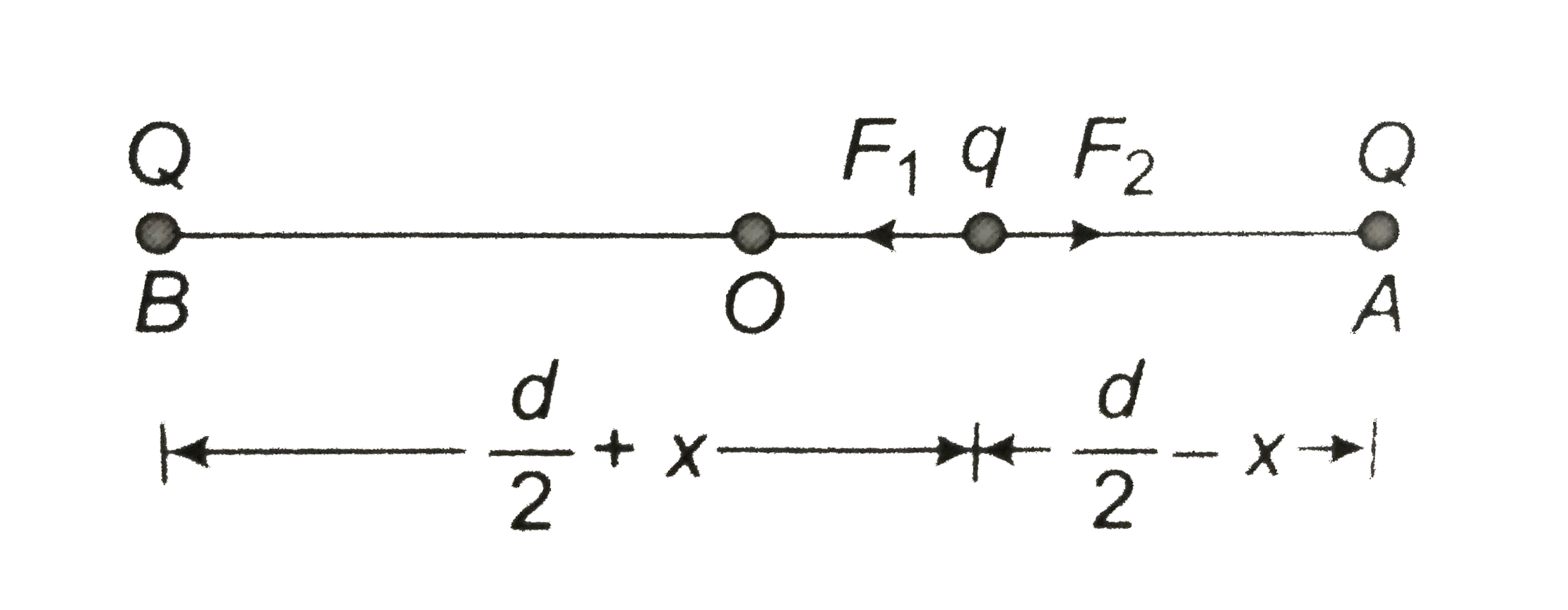Two positive point charges , each Q , are fixed at separation d. A third charge q is placed in the middle. Describe the equilibrium of the third charge.
If q is positive
(a) Net force on q is zero , hence it is in equilibrium . Let q be displaced slightly towards right by x.
Force on q:
Due to QatA,F1=14π∈0Qq(d2−x)2 , towards left
Due to QatB,F1=14π∈0Qq(d2+x)2 , towards right
F1>F2 , net force on q is towards left. Hence it will bring q to equilibrium position , and equilibrium is stable along the line AB.
(b) Let q be placed slightly perpendicular to line AB , as shown. The resultant force on q will be away from O and the particle will not return to its equilibrium position O, hence unstable equilibrium.
If q is negative
(a) If −q is displaced slightly towards right , the net force on it will be away from origin i.e. along OA and the particle will not return to its equilibrium position , hence unstable equilibrium.
(b) If −q is placed slightly perpendicular to line AB, the resultant force on −q will be towards equilibrium position , hence this force will bring −q to O, hence stable equilibrium.





Topper's Solved these Questions
Similar Questions
Two charges, each of −q, are fixed and separated by a distance 2d. A third charge q of mass m is placed at the mid-point of the two fixed charges. q is displaced slightly by x(x⟨), perpendicular to the line joining the two fixed charged as shown in the figure. q will perform simple harmonic oscillation if the time period of (SHM) is T=απ3ɛ0md3q2][12). Find α
'(##CEN_KSR_PHY_JEE_C18_E01_013_Q04##)'
View SolutionFour identical charges, Q each, are fixed at the vertices of a square. A free charge q is placed at the centre of the square. Investigate the nature of equilibrium of charge q if it is to be displaced slightly along any of the two diagonals of the square.
View Solution
Knowledge Check
Two point charges q each are fixed at (a,0) and (-a,0). A third charge Q is placed at origin. Electrons potential energy of the system will
Aincrease if Q is slightly displaced along x-axisBdecrease if Q is slightly displaced along x-axisCincrease if Q is slightly displaced along y-axisDdecrease if Q is slightly displaced along y-axisTwo point charges +q and −q are placed a distance x apart. A third charge is so placed that al the three charges are in equilibrium. Then
Auknknown charge is −4q/9Bunknown charge is −9q/4Cit should be at (x/3)from smaller chargge between themDnone of theseTwo force point charges +q and +4q are a distance l apart. A third charge q1 is so placed that the entire system is in equilibrium. Find the location, magnitude and sign of the third charge.
Aq1=49qBq1=−49qCq1 is to be placed at a distance l/3 from q.Dq1 is to be placed at a distance 2l3 from 4q.
(a) Two point charges Q and 16Q are fixed at separation d. Where should a third point charge be placed between them so that it experiences no force I.e. in equilibrium ?
(b) In the previous problem , if we replace Q by −Q , where should the third charge be placed on the joining the charges so that it is equilibrium ?
(c ) Three point charges Q,q and Q are placed at x=0,x=d/2 and x=d. Find q in terms of Q so that all charges are in equilibrium.
(d) Two point charges 9Q and 25Q are placed at separation d. Where should a third charge q be placed between them so that all charges are in equilibrium ? Also find the value of q and its nature.
View SolutionTwo particles (free to move) with charges +q and +4q are a distance L apart. A third charge is placed so that the entire system is in equilibrium.
(a) Find the location, magnitude and sign of the third charge.
(b) Show that the equilibrium is unstable.
View SolutionTwo identical point charges ,q each , are kept 2 m apart in air. A third pint charges Q of unknown magnitude and sign is placed on the line joining the charges such that the system remains in equilibrium. Find the position and nature of Q.
View SolutionTwo point charges +4q and +q are placed at a distance L apart. A third charge Q is so placed that all the three charges are in equilibrium. Then location. And magnitude of the third charge will be
View SolutionTwo positively charged particles each having charge Q and are d distance apart. A third charge is introduced in midway on the line joining the two charges. Find the nature and magnitude of third charge so that the system is in equilibrium.

View Solution
